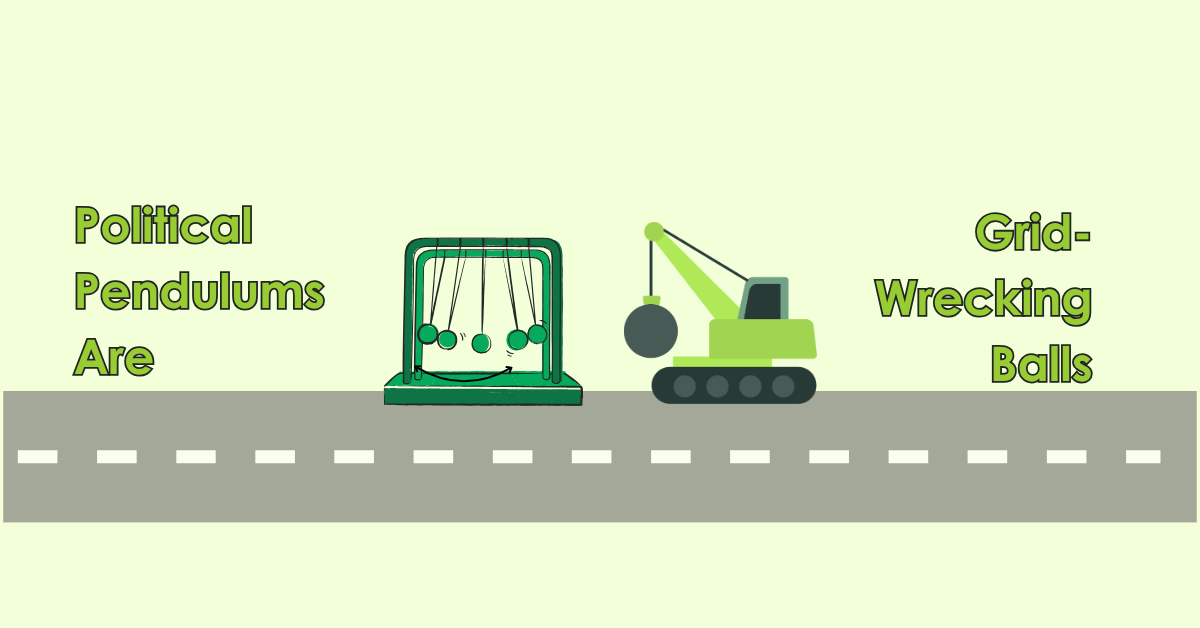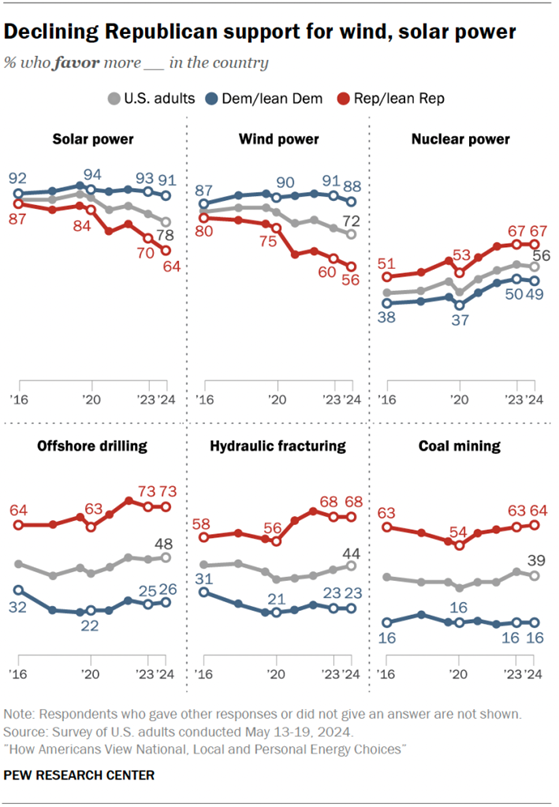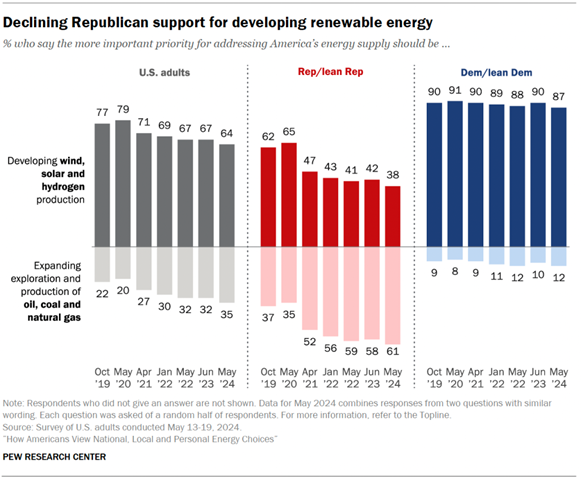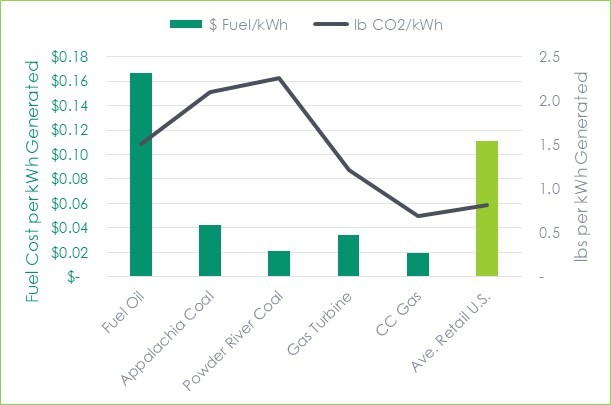
I could write about electricity shortages and data centers every week. Maybe I’ll attempt to keep it to one per month. There are many reasons it’s important, but the big one is that it drives load growth, strains the bajeezus out of the grid, and keeps thermal power plants online. Other outcomes:
- Coal plant retirements are being delayed or cancelled.
- Regulation seeping back into “deregulated” markets everywhere: Illinois[1], Texas, PJM, ERCOT.
- A resurgence in efficiency programs, do ya think? I don’t know.
- Complaining and belly aching? For sure!
I’ve written many posts explaining why electricity deregulation doesn’t work, including here, here, and here, in 2025 alone. I don’t think I’ve listed another big reason: the political pendulum. I mentioned this to a colleague a few months ago.
Pendulums
It works like this: every four or eight years max, one party comes into complete simultaneous Article I and II power in Washington, DC. The Democrats swing hard on renewables, stopping pipelines, and trying every means possible to make coal-fired power plants extinct. Remember the Clean Power Plan and the Mercury and Air Toxics Standards (MATS)? No problem, because I wrote about them ten years ago. The regulations were such that coal-plant operation was impossible per the Arms Race and Heat Rate Fairy posts. The Clean Power Plan officially died three years ago.
Of course, Trump swung into office and slammed the door on renewables, but at least they kept it open for battery storage. Not that batteries are the answer, but they are dispatchable while supplies last – for four hours. As I mentioned at the summer solstice, 2025, a broken clock with motors or springs is right twice a day.
“Clean Coal”
Trump has an unprecedented ability to speak with godlike assurance on topics he knows next to nothing about, like “clean coal.” “There’s never been anything like it,“ to use his language. All in all, it cracks me up. Surprisingly, and to be fair, Barack Obama was a “clean coal“ enthusiast in 2009. To be fair again, that was before the precipitous drop in renewable power-generating technologies.
What does clean coal mean anyway?
- Scrubbers to remove SOx (acid rain), NOx (acid rain, ozone, and less atmospheric methane destruction).
- Synthetic gasification to use gas turbines and reduce emissions of the above.
- Carbon capture.
Let’s see,
- Expensive.
- Insanely expensive.
- Prohibitively expensive squared.
I am between amazed and astonished at how much support there is for coal. Recent polls from the Pew Research Center (Figure 1) suggest that 39% of Americans, including 16% of Democrats (!), support coal. Per Figure 2, support for renewable electricity is declining, with nuclear power showing the greatest increase in popularity.
Figure 1 Energy Supply Preferences

Figure 2 Renewable Energy Sentiment

Why The Attack on Coal Was Unnecessary and Ineffective.
Makey no mistakey, coal’s decline has nothing to do with environmental concerns, despite what either political persuasion or utility may say. Some will take credit for the sunrise and declare they do it for the greater good.
The sunrise (fact) is that coal cannot compete with natural gas on operating cost. Not only does natural gas have price parity with coal, primarily because combined cycle natural gas plants are twice as efficient as coal or nuclear power plants, but there is no hassle with natural gas. Coal power plants require fuel handling, slag removal from boilers, and the nasty, nutrient-rich coal ash disposal.
Figure 3 shows fuel cost per kWh of electricity produced[2][3][4]. The fuel cost alone for combined cycle natural gas is on par with cheap, surface-mined Wyoming Powder River Coal.
Figure 3 Electricity’s Fuel Generation Cost

Paralyzing Wrecking Balls
Paralysis happens when politicians think they can design the grid. Wrecking balls are pendulums, too – and they make investors worse than nervous. The wind changes direction every 4-8 years, and the investors with hundreds of billions in cash they seek to put to work are on the sidelines for an industry that invests on a decades-long time scale.
He says grid and resource planning must be free of political hacks who know next to nothing about generation, transmission, distribution, reliability, resiliency, and price drivers.
As long as political power and executive orders radically change sides every four to eight years, expect the power sector to move forward with the alacrity of a comatose person tied up in a straitjacket.
Trending Battles of the Day
Meantime, the forward-looking political heat is on the rise. When prices of anything soar, the pitchfork and torch mob wants scalps. ZeroHedge blames Maryland Governor Wes Moore for soaring electricity prices in Maryland, the M in PJM, even though the grid operator covers 13 states. Why Governor Moore? Because he’s the one standing when the music stopped playing, and chairs were pulled from the circle.
In another PJM state, New Jersey, behind the J, electricity prices are central to the race for governor between Democrat Mikie Sherrill and Republican Jack Ciattarelli. Electricity prices in New Jersey increased 19% in the last year, versus 13% nationwide. 😐 Both numbers are atrocious.
ZeroHedge references a Bloomberg article that states, “Americans and their politicians have always been acutely sensitive to the price of gasoline. But there’s another cost-of-living issue that’s gaining prominence in the collective political consciousness: what consumers pay to keep the lights on.“ On any given day, Americans can tell you what a gallon of gasoline costs. Why? Because it’s in our faces in huge LED displays every day as we drive to work, school, the supermarket, or ball field. And people know what a gallon is because they buy milk, water, weed killer, and maybe even vegetable oil by the gallon and carry it home that way.
There’s nothing more transparent than the cost of gasoline. I even stumped Sam when I asked, “What is more transparent than the price of a gallon of gasoline?“ Who stumps AI? That’s what you get with the Energy Rant, thought winnership. Not just leadership. Winnership. Sam replied, “Honestly, not much.“
What do people know about units of electrical energy (kWh)? Not much, unless you’re a nerd in this industry, but even then, how they accumulate during daily life is a mystery, except for the most extreme nerds on the planet. So, yeah, nothing will be easier to spin and clobber politicians over the head than mysterious electricity consumption and prices. Better get some bubble wrap, Mr. Politician Man.
[1] Per Doug Scott, Illinois Commerce Commission Chair, considering a mini-Integrated resource plan, the first since deregulation in the state. https://wpui.wisc.edu/programs/2025-programs/load-growth/
[2]https://www.eia.gov/outlooks/steo/tables/pdf/2tab.pdf
[3]https://www.eia.gov/coal/markets/
